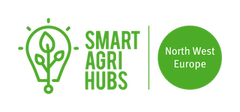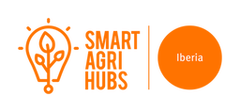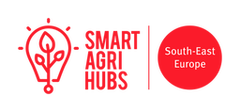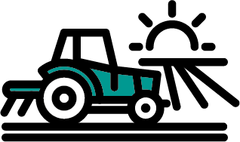of smartagrihubs
The magnitude
155+
Digital Inovation Hubs
9
Regional
Clusters
5
Sectors
28
Flagship
Innovation
Experiments
Flagship Innovation Experiments
In the spotlight
Farmcube
Farmers are often overwhelmed with data, and they have little to no tools available to them for integrated data analysis. When a farmer purchases a new sensor, they also receive a new login for a new platform in order to access the data gathered by this sensor.
North-west europe
Stream
magine being able to see an aerial image of your farmland, colour annotated into different areas according to the different farmland habitats it houses. That is exactly what we at FIE 2 STREAM are delivering: a sustainability tool for remote assessment and management of farmland.
UK & Ireland
FIE Irrigation Portal
Irrigation is one of the most crucial tasks in crop agriculture. It is also a very complicated one. The farming communities in Portugal and Spain cultivate many different crops, on various types of soil, in different climate conditions and using diverse irrigation infrastructure.
Iberia
Decentralisted Trust in Agri-Food
European consumers and food manufacturers face food supply chain that are often opaque and non-transparent. In fact, given the complexity of supply chain, 32% of manufacturers are unable to guarantee that the ingredients...
South East Europe
digi-pilote
“Alert: ‘your wheat is thirsty!’ The farmer opens his web app to look for more information. He sees that hardly any rain has fallen on his wheat fields and no rain is expected for the coming days. The graphs on his screen show him that his wheat crops are running out of water.
France
Farmcube
Farmers are often overwhelmed with data, and they have little to no tools available to them for integrated data analysis. When a farmer purchases a new sensor, they also receive a new login for a new platform in order to access the data gathered by this sensor. You can already imagine the problems arising when a farmer buys different sensors from different suppliers and attempts to read the data gathered on numerous different platforms. A plethora of data is useless for farmers if not embedded into a functional context that supports its practical application.
Farmcube allows the integration of data gathered by different sensors into an online environment. It is the landing place for all sensor data related to soils, crops and cultivation activities, with a focus on geospatial data – all of which is transformed into actionable insights. What’s more, we have developed Farmcube to be an open source development which allows farmers or service providers to contribute to the infrastructure – anyone can contribute and reuse the software, it is not limited to one brand or supplier. The product we are working on will be a Field Book application where farmers can view sensor data whilst in the field. The first data sources will be drones, satellites and machine implement generated data.
We try to spread our efforts equally over three main areas of activity: two of us work on machine data and look into how to use machine-generated data for dicumentation and analysis; two others work to make FieldBook a farmerpfriendly app that shows the data in relation to the farmer’s position in the field; another two are working on data-governance and how to guarantee software and data privacy. To make sure the development of our product is on tract, the team synchronises in a weekly sprint meeting.
The SmartAgriHubs ecosystem is incredibly useful to us. Several Digital Innovation Hubs and Competence Centres from the network help us with their knowledge and tools. Their experiences are very useful to prevent pitfalls. Moreover, they activate their network to help us make the most of our work!


Regional Cluster
RC North West Europe
Sector
Arable farming
End user
Arable farmers
Product
Integrated data online application
Contact
Tamme van der Wal
Partners
BIOSCOPE
Farmhack
Aurea Imaging
AVR
Wageningen University & Research (WUR)
ZLTO
Something funny/interesting
FarmCube is like climbing a mountain: the route is winding, windy and full of rocks, but the view from the top is breathtaking…
STREAM
Imagine being able to see an aerial image of your farmland, colour annotated into different areas according to the different farmland habitats it houses. That is exactly what we at FIE 2 STREAM are delivering: a sustainability tool for remote assessment and management of farmland.
The conservation and the protection of farmland wildlife and habitats is a key pillar of environmental sustainability. Most sustainability assessments require that farmland wildlife habitats are inventoried and mapped to be compliant with or meeting the benchmark of international accreditation and certification schemes. Moreover, we have also seen increasing demands from agri-food companies for wildlife value to be included in sustainability assessments. The issue, however, is that to produce a detailed farm habitat map for these assessments requires numerous fields visits by an ecologist to many farms. This is a time-consuming and expensive activity, and as a result conducting a farm habitat plan across farms becomes unattractive.
The successful use of aerial imagery removes this obstacle. Therefore, we are investigating the use and reliability of aerial imagery to identify farm habitats (Fig 1 & 2) and to produce customised farm habitat maps (Fig 3). Publicly available aerial imagery can be used by ecologists to distinguish among different types of habitats like heathland, intensively managed grassland, extensive grassland, ponds, lakes, arable crops, woodland, hedgerows, and so on. This information will be mapped by STREAM and can be used to inform the wildlife component of sustainability plans for the farm.
Our product will be a workflow to integrate a visual interpretation of aerial imagery into individual farm habitat reports. This includes state of the art image recognition technology to identify precisely the different habitat types, as well as an app to improve the capture and file transfer of photos by farmers for their inclusion in customised farm habitat reports. At present, we are requesting data permissions from farmers to use their farm maps. After this, we can assess the aerial imagery of their farms to identify the habitat types.
Developing this product would be a lot tougher without the SmartAgriHubs ecosystem. In fact, we benefit greatly from our cooperation with two Competence Centres: FERS has provided sample images from their existing bank of habitat images to another Competence Centre, TSSG, who have begun to enhance the machine learning algorithm to identify habitat types. All in all, we are happy to be part of this community and to be developing STREAM with your support.


Regional Cluster
UK & Ireland
Sector
Livestock farming
End user
all farmers
Product
Sustainability tool for remote assessment and management of farmland
Contact
John Finn
@johnfinn310
Partners
Teagasc
FERS
CodePlus
TSSG
WIT
Bord Bia
Something funny/interesting
We arranged a meeting between Teagasc, FERS and CodePlus, to discover that Pat in FERS and Tim in CodePlus went to school together and hadn’t met since leaving school!
Online Irrigation Portal
Irrigation is one of the most crucial tasks in crop agriculture. It is also a very complicated one. The farming communities in Portugal and Spain cultivate many different crops, on various types of soil, in different climate conditions and using diverse irrigation infrastructure. And actually, the management of those communities’ water needs requires an integration of technologies that allows farmers to bolster their activities on three fronts: agronomical, economic and environmental. How is that you may ask? Well, the Online Irrigation Portal allows the farmer to optimise water consumption and rationalise costs and fosters a better relationship between service provider and farmers.
Among the higher costs of agricultural management you can find the costs of irrigation, which are not exclusively water costs, but also energy costs related to irrigation activities. Furthermore, efficient water management is becoming ever more important for the environment. Therefore, a good management for the optimal consumption of such a finite resource is desirable. The online irrigation portal we develop makes this possible. How? Irrigation communities have data on their farms and crops such as water consumption, water costs, soil types and crop varieties. This data is gathered and implemented. Furthermore, by using IoT sensors and probes as well as weather forecasting, the online irrigation portal also captures data on agronomic conditions such as soil moisture, temperature, humidity, etc. Once all these data are combined in irrigation models, we have a digital-based service informing farmers and supporting irrigation activities.
The SmartAgriHubs framework in which we work has helped us out a lot. Our Digital Innovation Hub supports the coordination activities among all the partners and provides synergies. Also, our DIH recommended several actions for us to improve the potential results of the experiment (IoT-wise).
In the first 7 months of the FIE, our team was working on ironing out the foundation our journey’s success depends: planning and experiment preparatory activities, physical meetings with farmers’ communities, billing methodologies, IoT tool set-up, and so on. We also saw many coordination meetings to make sure that each member of the team had a clear definition of their tasks. Today, the team is developing the irrigation portal, so our IT developers are working very hard!


Regional Cluster
Iberia
Sector
Arable farming
End user
Farmers who need to irrigate their crops
Product
Web portal to support irrigation activities
Contact
Rafael Angel Ferrer Martinez
Partners
HISPATEC
EDIA
UNPARALLEL
FENACORE – Irrigators association
ABOVIGIA - Associação Beneficiários da Obra da Vigia
Something funny/interesting
We are digitising an agricultural technique which has been with us for millennia!
Decentralised Trust in
Agri-Food Supply Chains
European consumers and food manufacturers face food supply chain that are often opaque and non-transparent. In fact, given the complexity of supply chain, 32% of manufacturers are unable to guarantee that the ingredients they use are not fraudulent. As a result, in many instances both consumers and food manufacturers are left in the dark. Ironically, the data is kept in silos at every point on the supply chains. The problem however is that there are no incentives to share this data beyond the EU legal requirement of “1 step back, 1 step forward”. So, when a problem is discovered along the supply chain, it is hard to pinpoint specifically the location where the problem originated, thereby making recalls costly and wasteful...
Therefore, we want to bridge this gap in data by developing a web application that can connect data from across the supply chain. For our product, we are implementing blockchain technology (through the OriginTrail protocol) to integrate data from stakeholders across the dairy and poultry supply chains to improve the traceability of products. When a problem such as contamination is discovered, suppliers cannot retroactively change the data in the system to cover it up, since the OriginTrail protocol enables a quick discovery of any data discrepancies. What’s more: having all the data interconnected and accessible makes it easier to narrow down on the source of the problem which drives down the costs of a recall and prevents food waste. Of course, we are aware of the risks attached to gathering and centralising so much data. To deal with this, the data is kept on a decentralised network so that no central authority can take unfair advantage of the aggregated data.
We are currently well under way to achieve our goal. At the moment, most of our work is focused on software development and user interface design. We are also already conducting customer research and are actively looking into food producers’ and their customers’ needs. Especially at this stage, the advantages of being part of the SmartAgriHubs network become very clear. For example, BioSense, our Digital Innovation Hub, supports the FIE by creating a panel of users (farmers, food producers, consumers) from the poultry and dairy sectors that will test the solution. Moreover, they also provide consultation and support on the business models required to engage all relevant actors in a strategic way.
In the end, our combined efforts will translate into a user-friendly web application, also accessible by mobile devices with a QR code, available to dairy and poultry food producers. They in turn can make the application available to end-users to showcase their transparency and the high quality of their product (GMO-free, premium breeding). All in all, the quality of the food on our tables improves!


Regional Cluster
South East Europe
Sector
Livestock
End user
Dairy and poultry farmers
Product
Online web application
Contact
Anna Bevc
Partners
Origin Trail
Prospeh BGD d.o.o
BioSense Institute
Something funny/interesting
We are committed to sustainability by utilising an electric car-sharing service for our business needs.
DIGI-PILOTE
“Alert: ‘your wheat is thirsty!’ The farmer opens his web app to look for more information. He sees that hardly any rain has fallen on his wheat fields and no rain is expected for the coming days. The graphs on his screen show him that his wheat crops are running out of water. He decides to intervene and irrigate his fields.”
If it was up to us, this is how the future of wheat farming looks like! At Digi-PILOTE we develop an online Decision Support System that helps wheat farmers deal with their daily problems, in particular with those problems related to nitrogen supply and irrigation.
The window to apply nitrogen or water in the right place at the right time is very small. This makes it difficult for farmers to decide whether or not to intervene. In addition, because of the changing climate giving way to unpredictable weather patterns, this process is only getting harder. Therefore, the precise monitoring of wheat crops throughout the year provided by the Digi-PILOTE app offers a solution to farmers.
The app combines data from IoT sensors on the field and satellite imagery with analysis models to generate advice. This data is translated into user-friendly information on the app, and when anomalies are detected, the farmer will automatically receive an alert from the app. Moreover, an information system enables a connection between farmers’ plot management software and other operators’ (cooperatives, software vendors) decisions support systems.
Being part of SmartAgriHubs has allowed us to have testbeds! The project also opened a door for us to work with a Digital Innovation Hub called Digifermes. This network consists of 13 farms that serve as laboratories for research and tools like Digi-PILOTE. As a result, our solution is being tested on wheat fields in the South East of France. With the help of the hub we can continue to improve the application to make it as user-friendly as possible. In total, 50 to 100 farmers, 10 to 50 advisors and 300 field experiments are involved to make Digi-Pilote a success!


Regional Cluster
France
Sector
Arable farming
End user
Wheat farmers
Product
Decision support tool
Web application
Contact
Stéphane Jezequel (ARVALIS)
Emmanuelle Gourdain
(ARVALIS)
Partners
ACTA - ARVALIS- digifermes
ACTA – info
Groupe provence Services
API-AGRO
Coop de France Alpes-Méditerrannée
Something funny/interesting
What image do you have of French agriculture? A farmer with a beret on his head and a baguette under his arm leading his herd graze? Be that as it may, the project we are carrying out aims to show that traditional agriculture and new technologies are not incompatible and that their synergy can in fact bring a real added value to farmer’s jobs.
